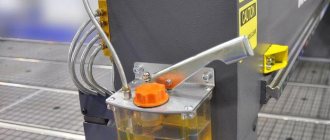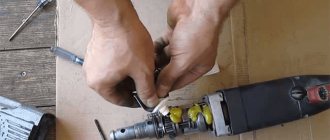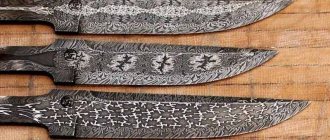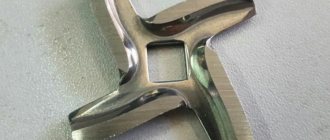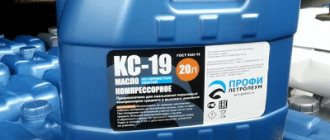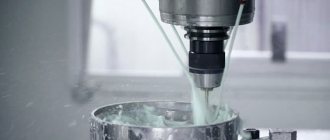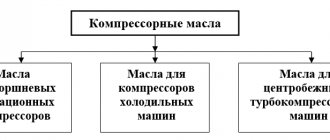Proper lubrication increases the durability of the machine, efficiency, drives, smoothness and noiselessness of the mechanisms.
The machine operating manual provides a diagram of the location of lubrication points and a lubrication map, which lists the elements of the lubrication system, the method and frequency of their maintenance, the brand and consumption rates of the lubricant.
In machine tools, liquid mineral oils and, less commonly, plastic lubricants are used for lubrication. The main characteristic of oil is viscosity. The higher the speed in the moving joint and the lower the specific load, the lower the viscosity should be.
There are the following lubrication options that can be used in machine tools:
1) drip (lubricant is supplied periodically using a lubricant through a shut-off needle);
2) oil mist (lubrication is carried out with a mixture of oil and air with strong spraying);
3) continuous individual (lubrication is carried out by gravity from the oil can to each rubbing pair);
4) periodic individual (lubrication is carried out periodically with a grease nipple of each rubbing pair);
5) lubrication under pressure (lubrication is supplied by a pump, grease nipple, etc.);
6) flow lubrication (carried out without returning used oil to the friction surfaces);
7) splash lubrication (lubrication of parts that do not reach the oil level is carried out using additional rings dipped in oil);
 wick lubricant (oil is supplied using a wick oiler);
wick lubricant (oil is supplied using a wick oiler);
9) centralized lubrication (carried out from one device for several rubbing pairs);
10) circulation lubrication (oil is reused due to its return to rubbing vapors).
Irrelevant supports and guides are lubricated using oilers that have a reservoir or are powered by syringes. A simple and common way to lubricate gearboxes is to spray oil on the gears, and in feedboxes the wheels are immersed in an oil bath. The centralized circulation lubrication system from the pump ensures a continuous and uniform supply of oil, insignificant oil losses, filtration, and good heat dissipation. An effective but expensive system is the lubrication of high-speed spindles with specially generated oil mist. The most perfect dosing is carried out periodically with a specified amount of lubricant. Below is a description of the lubrication system of the machine mod. 16K20.
General instructions
.
When preparing the machine for startup, it is necessary to rinse the filter mesh in kerosene, and then, in accordance with the lubrication diagram (Fig. 8.11, a
), fill the reservoirs with lubricant and lubricate the machine components manually according to the table. 8.2.
Lubricate with the specified lubricants or their substitutes. The machine uses an automatic lubrication system for the spindle head and feed box.
Gear pump 5, driven from the main drive electric motor through a belt drive, sucks oil from the reservoir and supplies it through strainer 7 (Fig. 8.11, a
) to the spindle bearings and to the oil distribution trays 10. Approximately 1 minute after turning on the electric motor, the oil indicator disk 1 on the spindle head begins to rotate, which indicates normal operation of the lubrication system.
When stopping it, you must turn off the machine and clean the filter 7. To do this, you need to remove it from the tank body and remove the filter elements in the plastic frame. Rinse each element in kerosene until completely clean. Do not blow out the filter elements with compressed air, as this may damage the fine mesh. After cleaning, assemble the filter, install it in the tank and connect the pipes. Read also: Diagram of a DC welding machine 305
Fig. 8.11. Lubrication diagram of the machine mod. 16K20
In a new machine, it is advisable to clean filter 7 at least twice a week during the first two weeks, and then once a month. To clean the filler filter 8 with a magnetic insert, you need to remove it from the tank, remove the lid, remove the magnetic insert from the glass and wash all surfaces in kerosene. The inlet filter 8 should be cleaned once a month.
The service life of turning equipment largely depends on the proper functioning of the lubrication system of the units, the surface of which is in constant friction against each other. Timely lubrication prolongs the serviceability of machines, reduces their power consumption, reduces the load on parts, and reduces their wear. In addition, the use of high-quality lubricants has a positive effect on the quality of turning, efficiency, and allows maintaining the temperature of the units in a given range. Factors such as the health of the system and the choice of suitable oil are decisive.
Lubrication systems for lathe components
The operation of lubricating devices that deliver oil to the required point is based on the simplest laws of physics:
- Gravity, allowing oil to flow to the friction point on its own
- Capillary forces, which, through porous bushings and wicks, lift the lubricant to a certain height.
- The viscous friction force generated between the surface and the lubricant material itself prevents the latter from flowing down.
- Pressure. Used in manual lubrication systems such as piston pumps and oilers.
- Centrifugal forces causing oil to flow under pressure to surfaces.
- Inertia. Due to the capture of liquid by the rotating elements of the machine, its particles are scattered.
- The pressure difference that creates self-suction of oil through the mechanisms themselves.
Changing the oil in a lathe
The service life of turning equipment largely depends on the proper functioning of the lubrication system of the units, the surface of which is in constant friction against each other. Timely lubrication prolongs the serviceability of machines, reduces their power consumption, reduces the load on parts, and reduces their wear. In addition, the use of high-quality lubricants has a positive effect on the quality of turning, efficiency, and allows maintaining the temperature of the units in a given range. Factors such as the health of the system and the choice of suitable oil are decisive.
Lubrication systems for lathe components
The operation of lubricating devices that deliver oil to the required point is based on the simplest laws of physics:
- Gravity, allowing oil to flow to the friction point on its own
- Capillary forces, which, through porous bushings and wicks, lift the lubricant to a certain height.
- The viscous friction force generated between the surface and the lubricant material itself prevents the latter from flowing down.
- Pressure. Used in manual lubrication systems such as piston pumps and oilers.
- Centrifugal forces causing oil to flow under pressure to surfaces.
- Inertia. Due to the capture of liquid by the rotating elements of the machine, its particles are scattered.
- The pressure difference that creates self-suction of oil through the mechanisms themselves.
Methods for lubrication of a lathe
1. Periodic manual lubrication - performed through technological openings that are closed during operation of the machine. To perform this, a syringe or oil can is used. A piston hand pump is used to deliver fluid to hard-to-reach places.
2. Drip or wick method - produced using drip or wick oilers by filling special containers. Of the latter, lubricant is continuously supplied to the surface of parts due to capillary forces.
3. Circulating lubrication - produced through the operation of a hydraulic pump, which supplies oil under pressure directly to the parts. The liquid drains naturally. The amount of lubricant supplied is regulated by special devices.
4. Crankcase method - produced by spraying oil with a fast-moving impeller or a gear immersed in a lubricant, connected to rotating parts of the equipment.
5. Combined lubrication - used in cases where the listed methods separately cannot provide optimal lubrication of mechanisms and parts.
Oil in a lathe performs the following functions:
- Protects mechanisms and parts from wear;
- Removes wear products from the working area;
- Removes heat;
- Reduces friction coefficient.
Types of oils for metalworking machines
When servicing equipment for metal turning, so-called industrial oil is used - a distillate petroleum product with low or medium viscosity. Its characteristic conditions of use are moderate pressure and thermal conditions, and you can buy it from any manufacturer. The main thing is compliance with GOST.
High-quality industrial oil for lubrication of machine tools has the following characteristics:
- Does not form foam;
- Does not form persistent emulsions with wear products;
- Resistant to elevated temperatures;
- Has high dispersing and washing properties;
- It has a stable chemical composition.
For industrial oils, the defining characteristics are:
- Density - has a greater effect on the properties of oils for hydraulic systems. Transmitting qualities decrease as the density of the liquid decreases.
- Viscosity is a parameter that directly affects the quality of the lubricant. It is the most important when choosing a lubricant for turning equipment. Depends on operating conditions, in particular on temperature. The higher the last indicator, the lower the viscosity.
- Flash point – affects oil consumption and waste. Essentially it is the ignition temperature of a liquid.
- Pour point – taken into account when storing liquid and transferring it.
- Ash content – degree of purification. The lower this indicator, the better the oil is purified.
- Acid number and sulfur content - the degree of purification from acids and sulfur.
To be sure which oil to pour into a particular lathe, its choice is made based on the manufacturer’s recommendations, which are necessarily indicated in the operating instructions.
Industrial oils for lubrication of lathes and drilling machines are divided into:
- And - without additives;
- IGP (alloyed) – with additives.
The following brands of industrial oils without additives are poured into the lathe:
- I-5A - used for lubricating mechanisms and components operating at high speed under light load, which do not require special anti-oxidation and anti-corrosion properties of the lubricant composition. At 40°C it has a kinetic viscosity of 6-8 mm2/s and a flash point of 120°C. In metal-cutting machines it is used to lubricate high-speed spindle units. Can be replaced with brands I-8A, ILS-5.
- I-8A is a similar brand to the previous one. At 40°C they have a kinetic viscosity of 9-11 mm2/s and ignite from 130°C. Can be replaced with brands I-5A, ILS-10, ILS-5.
- I-20A - used for lubrication of components operating at lower speeds and high loads, for example, sliding and rolling guides, gears. Viscosity 29-35 mm2/s and flash point from 180°C. Can be replaced with IGP-18 brand or another similar viscosity index.
- I-30A - in turning equipment it is mainly used for lubrication of the apron, drive shafts, slides, tool holder, and replaceable gears. Viscosity is 41-51 mm2/s and ignition occurs at 200°C. Can be replaced with brand IGP-30 or similar in viscosity.
- I-40A – Used for lubrication of gears. Viscosity 61-75 mm2/s and flash point from 200°C. Can be replaced with brand IGP-38 or similar in viscosity.
- I-50A - viscosity 90-110 mm2/s and flash point from 215°C. Can be replaced with brand IGP-38 or similar in viscosity.
1. Maintenance of the machine’s lubrication system by a turner consists of daily checking the oil level in the reservoir before starting turning work. If necessary, add liquid. When replacing, drainage is carried out through the plug. Before filling the tank, the latter is cleaned and washed with kerosene.
2. The apron mechanism has an automatic lubrication system with an individual pump. The oil level being filled is controlled by an oil indicator, usually located on the front side. The cross slide and carriage are lubricated at the beginning and middle of the shift until an oil film appears on the guides. Lubrication of the lead screw support bushings and guides during screw cutting operations is carried out with the uterine nut on.
3. The tailstock, lead screw and shaft supports are lubricated with wicks from the reservoirs. In the latter, oil must be poured until it flows out. Lubrication of the tapered axis of the tool holder is carried out daily at the end of the shift. In this case, the cutting head is removed.
4. All other points, with the exception of the replacement gears and the idler gear shaft, are lubricated manually with an oil can, which should be supplied with the machine.
5. To ensure long-term operation of the machine and turning accuracy, the turner constantly monitors the lubrication of rubbing parts. All oil holes, oil nipples and pipes that supply oil to lubrication points must be clean and capped.
Industrial oil is not a cutting fluid. Therefore, its use for lubricating cutting tools is unacceptable. For this purpose, a special coolant is used - an emulsion lubricating composition based on water and oil with various extreme pressure and anti-wear additives.
Wood and metal processing
A gear pump, driven from the main drive electric motor through a belt drive, sucks oil from reservoir 18 and supplies it through a strainer to the spindle bearings and oil distribution trays. About a minute after turning on the electric motor, the oil indicator disk begins to rotate. Its constant rotation indicates normal operation of the lubrication system.
The oil is drained from the spindle head and feed box through a strainer with a magnetic liner into the reservoir. During operation, monitor the rotation of the oil indicator disk. When it stops, immediately turn off the machine and clean the filter. To do this, remove it from the tank body, having previously disconnected the pipes, unscrew the nut located at the bottom, and remove the filter mesh elements in the plastic mandrel. Each element is washed in kerosene for complete purification. Do not blow out the filter elements with compressed air, as this may damage the fine mesh. After cleaning, the filter is assembled, installed in the tank and pipes are connected.
In a new machine, the filter is cleaned at least twice a week for the first two weeks, and then once a month.
To clean a filter with a magnetic insert, remove it from the tank, remove the lid, remove the magnetic insert from the glass and wash all surfaces in kerosene. The filter is cleaned once a month. Filters must be cleaned before and after each oil change.
Every day before starting work, check the oil level in the tank using the indicator and, if necessary, add it through the hole in the drain line. When replacing, the oil is drained from the reservoir through the plug. Before adding fresh oil, the tank is cleaned and washed with kerosene. The lubrication of the apron mechanism is also automatic, but is carried out by an individual plunger pump. Oil is poured into the housing through a hole closed by a plug, and drained through the hole. The oil level is controlled using the oil indicator. The guides of the carriage and cross slide are lubricated at the beginning and in the middle of the shift, alternately stirring the carriage and cross slide at high speed until an oil film appears on the guides. When screw-cutting work, the guides, as well as the lead screw support bushings located in the apron, are lubricated in the manner described above with the split nut turned off by the handle.
The supports of the lead shaft and lead screw and tailstock are lubricated with wicks from reservoirs into which oil is poured through holes closed with caps. The tailstock reservoir is filled until oil flows out through the hole (indicator). The replacement gears and the intermediate replacement gear axle are lubricated by hand with grease.
The remaining points are lubricated manually using an oil can.
The first oil change is 1 month after putting the machine into operation, the second is 3 months later, and then strictly following the instructions of the lubrication chart.
Repair of main components
bed
The 16K20 bed is a cast structure with stiffening ribs on which all other equipment of the lathe is mounted. On the top of the bed there are four longitudinal guides of the lathe: two flat and two prismatic. The positioning accuracy of the tailstock and caliper carriage, as well as the alignment of the front and rear stock, depends on the condition of their surfaces. The composition and procedure for performing the work is regulated by section 6.1 of the technical manual “Repair of a 16K20 screw-cutting lathe.”
There are four machining methods used to repair lathe guides:
- manual scraping;
- grinding using portable grinding equipment;
- grinding on surface grinding equipment;
- planing on a longitudinal planing machine;
https://youtube.com/watch?v=sJgzGG_6PU0
In general, if the wear is less than 15 microns per 1000 mm, the surface geometry is restored by manual scraping. If more, use machine tools or the spraying method.
Scraping is performed using hand tools, so its labor intensity is several times higher than with mechanized processing.
In addition, only non-hardened surfaces can be treated with this method. It is possible to scrape the bed of a lathe without dismantling the bed, therefore, along with manual grinding, this is the most common method of restoring guide surfaces.
Grinding of guides using portable grinding equipment installed on the bed is used in two cases: if it is impossible to deliver the bed to the repair shop and if the length of the bed is greater than the length of the grinding equipment table. The most effective way to restore bed guides is processing on grinding and longitudinal planing machines in repair shops or at specialized enterprises. It provides the highest precision and guarantees quality.
Bed for machine 16K20
Restoration of deep damage to the lathe bed is carried out by spraying brass or zinc, as well as filling it with babbitt. After filling the dents and potholes with metal, the surface of the guide is processed by grinding or scraping.
Carriage
In accordance with section 6.2 of the Technical Manual, repairing the slide carriage of a 16K20 screw-cutting lathe includes two technological operations:
- restoration of the lower guides associated with the bed guides;
- restoration of the transverse guides adjacent to the guides of the lower part of the caliper.
Before starting work, the carriage is installed on the exposed bed along with the rack and feed box. After this, clamping bars, an apron, a lead screw and a running shaft are mounted on the carriage, it is set for accuracy, measurements are taken and the engagement of the apron gear with the rack is checked.
Carriage for machine 16K20
Based on the results of control measurements, the degree of wear of the guide surfaces is determined and they are processed manually and mechanically until the standard straightness, flatness and parallelism are achieved. At the final stage, the accuracy of fit to the lathe bed is ensured by processing with a scraper and grinding devices.
Tailstock
According to section 6.7 of the Manual, the range of work for repairing the tailstock of a 16K20 lathe includes technological operations to restore the parameters of the following components:
- surfaces of the body mating with the surfaces of the plate;
- surfaces of the plate adjacent to the body and frame;
- hole for quill.
When restoring flat surfaces, scraping and grinding are used, and when processing quills, boring is used.
Grinding of flat surfaces of guides is carried out on a longitudinal grinding machine. Prismatic surfaces are brought to standard quality by scraping. Boring the hole for the quill is done in two ways: on the machine itself using a boring bar and with dismantling on a boring machine.
Maintenance of screw-cutting lathes
Screw-cutting lathes are used in various industries, most often they can be found in machine-building industries. Any work must be done with high quality, but details on which human life and health may depend must be done with special filigree, which can only be done on a perfectly adjusted, properly functioning machine. In order for it to serve for a long time, and for the threaded parts to meet their intended purpose, it is necessary to properly maintain the turning equipment.
Overview and diagrams of common models
Among the diverse model range and several generations of machines that are produced by our production, there are several models that continue to be popular for their technical characteristics and universal properties.
All of them are used in production or in domestic conditions to this day. At the same time, they continue to be worthy competitors to foreign analogues.
These are reliable, durable and durable devices capable of performing a huge number of different functions.
1L532
One of the most popular machines in the former USSR, which can successfully process workpieces of medium and large sizes.
At one time, this equipment was successfully exported to many countries around the world. Accuracy class – N. Machine weight – 43 tons.
16U04P
High precision equipment. The largest diameter of the part processed above the bed is 200 mm. Machine weight – 750 kg.
1P611
Lathe 1I611, used in production, including for turning wheels of railway vehicles. According to GOST, they are distinguished by increased accuracy and have the ability to brake the spindle. Device weight 560 kg. Easily performs the following functions:
- Drilling.
- Segment.
- Cutting internal and external threads.
- Treatment of various surfaces.
The largest diameter of the workpiece above the bed is 250 mm.
1D601
This machine is better suited for purely domestic use. The accuracy is lower than the previous machine. It features high performance even after many years of operation.
Moving the caliper is only possible manually. The weight of the entire machine is about 30 kg. Due to the small dimensions, the maximum length of the workpiece to be processed is 18 cm.
16K40
One of the most popular models that has really gained popularity among craftsmen. Belongs to the middle class of equipment with accuracy class N.
Since 1932, several tens of thousands of various screw-cutting lathes have been produced in the USSR. They were used not only in production, but also for training young people, in schools, colleges, and many had desktop machines in garages, homes, and their own workshops.
Daily care
The most reliable care for a lathe is to prevent damage to it. Preparation for the next work shift should be carried out immediately after finishing work and disconnecting the machine from the power supply. At this stage of maintenance, the following operations are performed:
- Chips and other technical debris are swept away from the surface.
- It is necessary to dissolve oil and dirt with kerosene and wipe dry with a rag.
- To avoid corrosion, all parts that do not have a paint coating are lubricated with oil.
- The oil cans are filled with grease.
Before starting a shift, it is necessary to check the presence of lubricant and inspect the equipment for damage or loose parts. During work, it is necessary to observe safety precautions when working with turning mechanisms - this will minimize injuries in the workplace and reduce the risk of equipment breakdown. During work you must:
- The use of protective screens, which will avoid clogging the lathe with metal shavings and small abrasive particles that arise during processing of the part.
- Timely replacement of drilling and cutting parts.
- Control over the reliability of fastenings of cutters and drills.
- During operation, do not allow the formation of long chips, which, if wound around the rotating parts, can damage the mechanism.
- You can turn on the machine only after the cutter is lowered onto the blank, in the place specified in the drawing.
Video covering basic maintenance principles.
How does the machine lubricate automatically?
Lubrication of a screw-cutting lathe, or rather its moving parts, must occur constantly during operation. The supply of lubricants to the rotor is indicated by the rotating disk on the spindle head. Its rotation should begin within a minute after starting the equipment. This time should be enough for the gear pump, connected by a belt drive to the main engine of the unit, to supply oil to the reservoir. The lubricant will reach the engine bearings and oil distribution trays through a strainer with a magnetic liner. The system is closed - flowing into the spindle head, the oil again enters the reservoir, where it is cleaned of debris by a filter and again ends up on the moving parts.
Intermittent movement or stopping of the disk indicating the flow of lubricant to the parts of the screw-cutting lathe indicates that the filter is clogged or there is not enough lubricant in the system. In this case, the machine must
- disable,
- cut off the power
- remove the filter,
- wash it with kerosene,
- check the lubricant level in the reservoir,
- add oil if necessary,
- insert the filter into place and start the unit.
How to remove the filter
The mesh filter consists of several elements. To get it out of the tank, which serves as the filter housing, you need to disconnect the hoses from it, unscrew the bottom nut, and remove the filters along with the plastic frame.
Attention! Filters can only be washed in kerosene. Under no circumstances should they be cleaned with air. This method of cleaning can lead to the immediate loss of the mesh’s working qualities. Strong air pressure deforms its cells.
Scheduled maintenance with mandatory filter washing is carried out in accordance with the instructions in the technical data sheet of the equipment.
Scheduled preventive maintenance - PPR
Scheduled preventive maintenance is a set of measures to maintain the machine in working condition while maintaining its technical characteristics at the level corresponding to those specified by the manufacturer in the machine’s passport.
In accordance with the maintenance schedule drawn up based on the operating mode of the unit, the following is carried out:
- Maintenance – cleaning, lubrication, filling and changing oils.
- Replacement of worn parts and dull cutters.
- Washing the entire machine or its individual components.
The preventive maintenance plan should include:
- preventative repairs;
- current (small and medium) PPR;
- capital PPR.
Between-repair maintenance
Compliance with the operating requirements stated by the manufacturer refers to:
- equipment control mechanisms;
- workplace barriers;
- maintaining lubricating devices and reservoirs clean, monitoring their filling with lubricants.
- troubleshooting minor problems;
- adjustment of adjustable mechanisms.
All of the listed types of maintenance do not require much time, which allows them to be carried out during technological, lunch, and inter-shift breaks. It is better to schedule equipment readjustment on weekends. For high-level turners with permission to carry out a certain type of adjustment work, this will not be difficult. In other cases, it is necessary to add this type of minor repair to the to-do list for the workshop repair and commissioning team.
PPR of automatic machines is carried out daily, after the end of the shift. When the workshop operates in 2 and 3 shifts, they are serviced once every 8 hours. In workshops with a shift work schedule, there must be a repair and adjustment service consisting of:
- mechanics;
- lubricants;
- locksmiths;
- electricians;
- saddlers and other specialists of a narrow profile.
This should ensure high quality of each unit individually, and the machine as a whole.
Current repair of the machine
Milling machine repair
Current repair of the machine
To maintain production equipment in good condition, it is necessary not only to perform maintenance, but also to carry out such activities as routine and major repairs. Both types of activities are fundamentally different from each other, both in the goals pursued and in the degree of labor intensity, the list of work performed and the budget (see “Types of machine repairs”).
Routine repair of a machine (aka operational) is a set of measures aimed at eliminating malfunctions and the consequences of wear of individual components and mechanisms. In most cases, such work does not require removal of the unit from production, but is carried out at the installation site or in the repair shops of the enterprise. Maintenance repairs are not planned in advance, since they are associated with unpredictable breakdowns. Accordingly, it is impossible to determine the volume of work and the costs for it.
Routine repair of a machine involves two methods of implementation - individual and aggregate. With an individual restoration option, all faulty components are removed from the car, restored and reinstalled. The aggregate repair method involves installing parts from the reserves of the exchange fund. As for damaged spare parts, they are repaired and then replenish the stock of the exchange fund. This method can significantly reduce equipment downtime.
During a major overhaul, a complete revision of the structure is carried out, which requires not only specially equipped areas, but also special qualifications of specialists. The unit is disassembled into its component parts, and after checking for suitability for use, the parts are divided into three groups - serviceable, repairable and non-repairable. After replacing worn-out components, the machine is assembled, tested and debugged.
Unlike current repairs, major repairs guarantee proper operation of all components for at least ten years. As for operational measures, in relation to a unit that has served for 15-20 years, they do not give confidence in “tomorrow”, since the general high wear and tear of the mechanisms will constantly make itself felt with failures in one place or another.
After a major overhaul, you can forget about all the problems associated with resource depletion for a long time. In addition, as a rule, such measures are accompanied by modernization of equipment, thanks to which design imperfections are eliminated and the operational parameters of the machine are improved.
In general, the overhaul returns the unit to the passport accuracy standards, thereby improving the quality of the products produced, and also increases the safety, productivity, and efficiency of the equipment. All this, together with the highest level of modernization, compared to the purchase of new machine tools, will reduce costs by at least half.
The design bureau of "Modernization of Industrial Equipment" in Kolomna accepts old and new generation machines, both domestic and foreign, for current and major repairs, +7,.
Source
Equipment maintenance records
In every workshop equipped with machines, a maintenance log must be kept. At the end of each shift, workers must leave notes in it about the serviceability or malfunction of the machine, indicating defects, breakdowns, the need for any unscheduled work, or complaints about the operation of a certain unit or mechanism.
After inspection and carrying out the necessary list of work, the adjuster also submits a report on the work done, indicating the breakdown and a list of repair actions performed.
Washing of machines is carried out according to a schedule drawn up by a mechanic, in accordance with the manufacturer’s recommendations in conjunction with the operating mode of the machine.
Geometric rigidity testing is based on GOST requirements. It is carried out after work of medium complexity or major repairs. The basis for this check is the schedule drawn up by the mechanic for carrying out maintenance work. The list of machines subject to this inspection is compiled by the chief production technologist.
Repair cost
The purpose of the overhaul is to restore the initial accuracy and safety of service of a machine with an expended resource. The cost of overhauling a lathe is usually less than 50% of its market value: for this reason, repairing it is cheaper than purchasing a new one. In addition, repairs are often ordered for original machines that are no longer in production or are made according to a special order.
Major repairs include:
inspection of equipment performance before disassembly;
- disassembly, washing, cleaning, troubleshooting of worn parts;
- grinding and restoration of the base surface;
- replacement of parts when repairing units if they cannot be restored;
- if necessary, replace or improve the electrical control system;
- galvanizing or painting parts, if they need to be processed in this way;
- assembly of a repaired machine;
- checking equipment for accuracy in accordance with specifications;
- checking operation at idle and under load;
- ultimately – commissioning.
In addition, the price for repairs depends on the type and type of turning equipment and the degree of wear of parts.
It is worth understanding that lathes are expensive equipment. Therefore, before you start repairing yourself, you need to weigh the pros and cons. If you lack experience, you can render it completely unusable.
Areas of use of turning equipment
Screw-cutting lathes vary in weight and size, which directly depends on the industry where they are used. They can produce short and long, thin and wide parts. These lathes can cut internal and external threads on parts. The heavier the part, the more massive the machine for processing it.
Light weight turning equipment is used:
- in experimental workshops;
- in instrument making;
- in the manufacture of watch movement parts.
This type may have a mechanical supply of blanks to the cutter, which allows for faster production of identical parts, if necessary, to produce them in small batches. For the production of piece products, this mechanism is not required, which will be reflected in the design of the lathe.
In the industrial production of threaded parts and tools, medium-weight machines are more often used. Their design contains many automatic systems, which, along with rotary mechanical parts, require preventive checks and debugging. Moving, twisting, rotating, cutting and drilling parts require regular lubrication.
Heavy weight turning equipment is used for more repetitive operations. On it are machined:
- shafts;
- turbines;
- wheels for trains.
Despite the small range of products and a small selection of operations, these machines cannot be called simple. There are also many components in its design that require constant care and monitoring. Lubrication and cleaning of parts becomes more difficult due to their heavy weight.
Areas of application
The 1615 lathe is designed specifically for machining relatively small parts using high-speed cutting and carbide tools. Its functionality allows you to process not only metal workpieces, but also parts made of other materials. The capabilities of the presented equipment are expanded due to additional functions, such as cutting metric, inch, and modular threads.
Depending on the technical characteristics and parameters of a particular model, screw-cutting lathes 1615 are used at home for piece production. It is also allowed to operate them in industrial enterprises for the purpose of mass production.
Types of machine maintenance
According to GOST 18322, machine maintenance is divided into the following types:
In production, equipment maintenance is usually divided into:
routine (cleaning and lubrication of externally accessible components and mechanisms, control of heating of rubbing parts, etc.), which is the responsibility of the machine operator;
scheduled (cleaning and lubrication of components and mechanisms that require disassembly, changing oil and filters, adjustment, adjustment) - it is performed by the mechanic service.
Frequency and rules of maintenance, selection of oil and lubricant for metal-cutting machines
The main document defining the rules of care and frequency of maintenance is the machine passport. The points to be lubricated, the type and amount of lubricant for each of them are indicated in the lubrication card and table.
If operating conditions require changing the intervals between maintenance and/or using lubricants of other brands, the company’s chief mechanic service draws up its own maintenance cards.
Oils for metal-cutting machines must have high washing ability - small metal shavings and dust generated during the processing of workpieces accelerate the wear of rubbing pairs. Their viscosity is selected taking into account the speed of operation and the degree of load of the mechanisms.
Machine oils of the brands ZIC, Mobil, Mannol have excellent performance characteristics.
Oil coolants form a film that is difficult to remove on the surfaces of machine tools. The use of synthetic compounds reduces the time spent on equipment maintenance.
Maintenance of lathes
The lubrication system of a lathe is not simple: many friction pairs operate at different loads and speeds, and therefore require the use of different lubricants and methods of supply.
What kind of oil should I pour into the lathe and what should I use to lubricate the guides? Industrial oil I-20A flows into the oil tank, I-30A into the feed box and apron, and I-12A into the spindle head. To lubricate the guides, it is recommended to use oils with anti-jump additives.
During daily maintenance of the lathe, the oil level should be checked at all sight eyes and topped up if necessary.
Replacing coolant and flushing the system
To ensure that fresh coolant has a long service life, it is recommended to pour a system cleaner, such as OILCOOL XR, into the reservoir before the last start of the machine. It effectively dissolves dirt and deposits on surfaces. After 8 - 24 hours, it is necessary to drain all liquid from the system and rinse it with water.
The system cleaner completely removes the remnants of the old emulsion, so after flushing with its use, it is possible to fill the machine with a different brand of coolant.
In conclusion of the article, we suggest watching a video tutorial about the rules of maintenance of a lathe:
Source
Specifics of maintenance of CNC machines
In addition to general care rules, daily maintenance of computer-controlled machines includes:
thorough cleaning of the read heads;
checking the serviceability of pneumatic and hydraulic systems, CNC devices;
monitoring the condition of the most vulnerable parts and assemblies;
adjusting the accuracy of operations.
During routine maintenance of CNC machines, special attention is paid to cleaning dust from the electronic and electrical parts of the equipment - dust jumpers can lead to current leaks, reducing the accuracy of its operation, and short circuits on boards.
How to lubricate a CNC machine in the absence of lubricants recommended by the equipment manufacturer is decided by the chief mechanic’s service.
The most commonly used oils for CNC machines: for lightly loaded high-speed mechanisms - I-5A, I-8A, as the speed decreases and the load increases - I-12A, I-20A, I-30A, I-40A, I-50A.
What oils are suitable for ball screws
Among domestic lubricants, divided into lithium, barium and hydrocarbon, lithium is considered the most popular, with a combination of valuable performance qualities. Therefore, lithium greases have received universal recognition in the world as ideal. Among them is Litol-24 - the product is a soft ointment that has a cherry or brown color. This class of lubricants includes CV joints-4 and Fiol-2U.
What about Ciatim-201? This multi-purpose lubricant, which retains its properties at low temperatures - up to - 60 ° C, is used in friction, sliding and rolling units. Thanks to this, it was used in the Far North.
But this lithium grease is mechanically unstable. It is better to prefer several foreign analogues of this lubricant: BP Energrease, Mobil Мobiltemp, AeroShell Grease, Teboil 0-Grease. There are analogues among domestic products - Zimol, Era, Lita, MS-70 and others.
In the process of caring for ball screws, Molykote Multilub is used, a multifunctional lubricant made from mineral oil, and lithium soap is used as a thickener. Its main advantages:
- increased load-bearing capacity;
- low oil volatility;
- good resistance to oxidation;
- the presence of extreme pressure additives among the components;
- Units lubricated with it work for a long time without repairs or additional lubricants.
The product is available in 100 and 400 g, 1, 5, 20, 50 and 180 kg packaging.
If you carefully read the technical documentation (and this must be done), you can learn about the expanded scope of Molykote Multilub:
- linear bearings of machine tools;
- the lubricant adheres well to the bearings of the spindles and guides;
- it can be used to lubricate various friction units;
- The bearings of the electric motor and fan, the gear drive (open and closed), and keyed connections are lubricated.
And these are not all the benefits of oil.
Another great product from Molykote
The company Molykote (Netherlands) also produces Multigliss Spray dispersion in 400 ml packaging, which is convenient for an individual who has only a CNC machine at home. And enterprises with a large fleet buy 5 liter packaging.
For large enterprises in the industry, where there are a large number of machines, it makes sense to purchase Molykote Multigliss dispersion with a volume of 200 liters. By the way, large packaging is not always in stock, so it’s worth ordering a notification on the website about its arrival at the warehouse.
Features of maintenance of other types of machines
Milling
When maintaining a vertical milling machine, you need to monitor the oil level in the circulation system and hydraulic system, and refill the oil nipples of the guide slide, table, milling head, and table lifting and moving screws two to three times a shift.
Laser
Maintenance of a laser machine consists not only of timely lubrication of rubbing pairs. In addition, you need:
Before starting work, check whether the laser tube is completely filled with water, clean the reflectors and focusing lens from dirt, and check the optical trajectory;
clean the linear guides and chiller every two weeks, change the water;
If air pumping deteriorates, clean the corrugations and the hood from dust from the inside.
Bending
Gear or transmission oil with anti-corrosion additives is poured into bending machines, the viscosity of which depends on the ambient temperature. For example:
Bending machines installed outdoors require seasonal maintenance with the replacement of “summer” oil with “winter” oil or vice versa.
Before adding new oil to the bending machine, the tank and lines must be thoroughly cleaned.
Format-cutting
Maintenance of a formatting saw, like any other woodworking equipment, involves regular care of its external and internal surfaces - sawdust and dust accumulating on them are fire and explosion hazards.
When choosing what to lubricate the saw, give preference to compounds that prevent resin, dust, and shavings from adhering to the metal.
Drilling
During maintenance of the drilling machine, it is necessary to ensure that no lubricant gets on the contact surfaces of the spindle and chuck - this can lead to an accident.
Grinding
During daily maintenance of the grinding machine, it is necessary to thoroughly clean its surfaces from abrasive dust and remove sludge from the coolant settling tank, during routine maintenance, monitor the condition of the fine oil filter, and clean the tank and magnetic separator at least once every three months.
Rocking machine
Maintenance of the pumping machine is carried out twice a year in order to prepare for work in the autumn-winter and spring-summer periods, combined with scheduled repairs.
Mistakes and ways to avoid them
The main mistake of the machine operator is the lack of regular lubrication of the device. To fix this, you should thoroughly clean all components, and only then apply oil.
Mixing different oil compositions will also be detrimental to the machine. This deteriorates the design of the components and even peripheral materials. If this happens, you need to try to clean all the lubricated parts (most likely, this will have to be done several times, since the oil will not go away quickly), and then use oil of a homogeneous composition.
Another mistake is lubricating only a certain area of the machine and not distributing it throughout the entire device. In this case, the operator will be confident that the machine is serviced and can be fully loaded. But in fact, many parts will remain contaminated with dust and waste. Therefore, when lubricating, it is important to run all guides and axes.
Lubrication will help prolong the operation of the machine even under high loads. It is important to do this regularly in compliance with all the rules.
- November 09, 2020
- 1735
Lubricant selection for guides
The best lubricant for guides is the one indicated in the equipment data sheet. If it is lost, you should choose what to lubricate the machine guides with, taking into account:
location in space;
material of rubbing surfaces;
operating temperature range.
To lubricate the horizontal sliding guides, anti-slip oils of ISO viscosity class 68 are used, and for vertical sliding guides, viscosity class 220 is used.
Which lubricant is best for rolling guides depends on the speed of operation and the degree of load - the lower the speed and the higher the load, the more viscous and dense the lubricant should be.
When deciding how to lubricate the linear guides of a machine, it is necessary to take into account the features of their design, movement speed, and specific workloads. Heavily loaded mechanisms require the use of high-viscosity extreme pressure lubricants, while high-speed ones require low-viscosity oils with improved anti-friction properties.
Mobil Vactra Oil series oils greatly facilitate the selection of lubricants for guides: they are suitable for any combination of materials of rubbing pairs.
